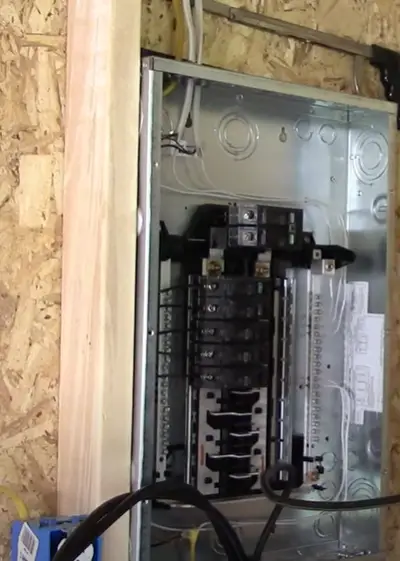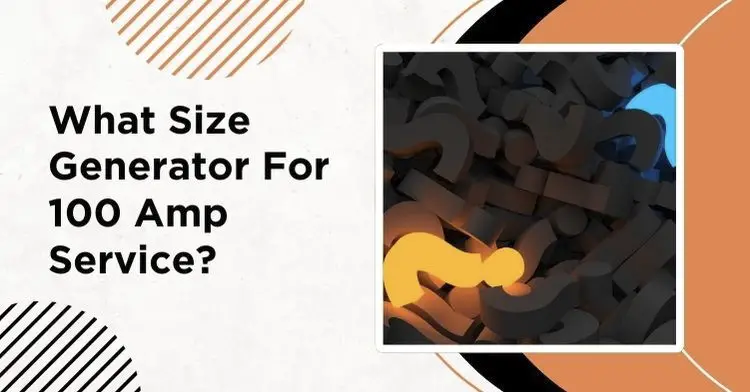What Size Generator For 100 Amp Service?
If you have a 100 amp service panel at home or in your small business, picking the right generator is important to keep everything running smoothly during a power outage. A 100 amp panel can handle many everyday appliances, but you need the right size generator to match its capacity. In this guide, we’ll help you understand how to choose the best generator for your 100 amp service so you can stay powered up when you need it most.
Contents
What Size Generator For 100 Amp Service?
A 100 amp panel is mainly made for homes and small businesses. It is ideal to power up a small to medium refrigerator, a 1-ton to 1.5-ton air conditioner, a dishwasher, and a few fans and lights. The service panel isn’t made for large home appliances.
Therefore, you won’t need a big generator for it. However, you may still ask, “What size generator for 100 Amp service panel is ideal?” When you know the electricity handling capacity of the service panel, you can quickly find the right generator for it too. Understanding generator power is crucial, as the generator’s output capabilities about their amperage ratings can vary. While a transfer switch may handle 100 amps, the generator itself might deliver significantly lower amperages. Choosing reliable generator manufacturers known for quality and durability is also important.

You’ll typically need a 10kW to 15kW generator for a 100 Amp service panel, but the exact size depends on the appliances you plan to run. It will be adequate to provide 100% backup to all the home appliances connected with the service panel. However, many experts suggest that you will need a higher-powered generator if you plan to run air conditioners with the service panel.
So, we will look at the devices you may run with the 100 Amp panel. Then, we will elaborate on the generator size requirement for the service panel.
Appliances That You Can Run Using 100 Amps
When you need a generator for the 100 Amp panel, you should first know its capacity. For this, you must count how many home appliances it runs and their total wattage requirement. Generators are rated based on their ability to sustain power output at full load, which is critical for ensuring reliable operation of appliances and systems during utility outages. Once you have calculated the wattage of all the devices connected with the 100 Amp service, you can purchase the correct generator accordingly.
Understanding the concept of total load is crucial. It ensures that the electrical setup is adequately aligned with load requirements and equipment specifications, preventing any potential overloads.
However, you must understand that the 100 Amp service panel isn’t made for large residences and industries. It will only accommodate a few small to medium home appliances within its limited amp rating. If you have bigger devices such as a whole-house heater or central air conditioner, you should pick a panel with at least a 200 Amp rating.
A 100 Amp service panel is usually enough to power several appliances in a medium-sized house, but it’s not ideal for large or power-hungry devices. Usually, the board will run with a 120V cable. It also includes some appliances of 240-volt along with air conditioners. However, the panel isn’t suitable for multiple and large air conditioners. You can run only one air conditioner with a 100 Amp-rated panel.
Also, its capacity shouldn’t be more than 1 ton to 1.5 tons. You need to shift to 150 Amp rating or 200 Amp rating panels for a larger air conditioning machine. When calculating the size of a generator, consider the power requirements of a heat pump, as it typically requires a significant amount of power.
You may want to improve the electrical service to get more power if you have planned to complete an essential restoration or house addition. For example, when you have a 12-volt and 100-ah battery, it can run an appliance of 100W for about 20 hours with a draw of 5 amps per hour.
Drawing over five amps an hour quickly decreases its ability because of energy losses and inverter inefficiency. But it’s pulling less slowly than the release rate. Although the slow release of battery or electricity seems impractical, in reality, it improves the performance and consistency of the devices. So, you don’t need to be anxious about it. All you need to do is focus on how much Amp the device consumes.
When you know the Amp requirement of all the devices, you can quickly sum them up for an accurate calculation. Usually, the 100 Amp service will have enough current at its disposal to run essential home appliances.
It includes:

- One medium air conditioner (Capacity less than 1.5 tons)
- One refrigerator (Its size shouldn’t be more than 22 cubic feet)
- Alternatively, you can run a chest freezer or deep freezer
- Microwave oven
- Coffee maker
- Blender and juicer
Avoid connecting high-power devices to a 100 Amp panel, as it’s not designed to handle heavy loads. Thus, you should avoid connecting dishwashers, electrical furnaces, central room heaters, or air conditioners with the 100 Amp rated panel. Or else the service panel will break down and get damaged permanently. So, consider the Amp requirement of your home or small business while installing the panel.
100 Amp Service Can Run Other Appliances
You already know that 100-amp service is typically good enough to run smaller to moderate-sized houses with general branch circuits. Moreover, it can run one or two larger electric appliances. The appliances include a water heater, a range, or a cloth dryer. Determining the appropriate generator sizing based on specific power needs is crucial to ensure reliable performance.
If your heating appliances work on gas, this service would be adequate for a house under 2,500 square feet. For example, a lead-acid battery with a 100ah deep-cycle can run a refrigerator for more than 13 hours using 630kWh/year. We assume it’s 80% of the discharge.
But, it has recommended 50% DoD with the same battery. In this case, it’ll run a refrigerator for more than 8 hours. If you go with a 100-ah battery made of lithium iron phosphate, it’ll run in a fridge for more than 15 hours with a 95% discharge rate.
What Size Generator For 100 Amp Service Is Suitable?
We have described the number of home appliances a 100 Amp panel can handle. Once you have summed up their wattage requirement, it’s time to pick the right generator. Alternatively, you can find the voltage of the wring and calculate the generator size accordingly. Additionally, consider whether the generator can operate using natural gas, as this can impact its efficiency and capability.
Typically, a 100 Amp panel will run with 120V wiring. So, its electricity handling capacity will be 12000W which is the multiplication result of its amp-rating and voltage. If the service panel runs at 220V, its capacity will be 22000V. Considering 15% power loss, the actual wattage handling capacity of the 100 Amp panel will be around 8000W to 15000W, mostly.
You can pick an 8kW to 15kW generator for a 100 Amp service panel, but make sure it meets the specific power needs of your connected appliances. Also, it will be a safer option for the panel to run without any inconvenience.
Related Articles:
- What size generator for 150 amp service?
- What size generator for 200 amp service?
- What size generator for 400 amp service?
- What size generator for 500 amp service?
- What size generator for 600 amp service?
Conclusion
In conclusion, choosing the right size generator for a 100 Amp service doesn’t have to be complicated. By understanding your home’s power needs and considering factors like the types of appliances you’ll be running, you can select a generator that keeps everything running smoothly during an outage. Whether you opt for a 10kW to 15kW generator or something larger, make sure it’s properly installed and maintained for safety and reliability. With the right setup, you can enjoy peace of mind knowing that your home will stay powered, no matter what comes your way.
Frequently Asked Questions (FAQs):
How many watts can I run on a 100 amp service?
On a 100 amp service, you can run up to about 12,000 watts safely. This is based on a typical voltage of 120 volts, where 100 amps multiplied by 120 volts equals 12,000 watts. However, if your system uses 240 volts, you could handle up to 24,000 watts. Always consider that running at full capacity all the time isn’t ideal, so it’s best to stay a bit below these limits to ensure everything runs smoothly and safely.
What is the max breaker size on 100 amp service?
The maximum breaker size for a 100 amp service is typically 100 amps, which matches the service’s capacity. Using a breaker larger than this could overload the system and create safety risks. Always ensure your breakers are appropriately sized to match the service panel to prevent potential electrical hazards.
Are there any specific considerations for generator installation with a 100 Amp service?
Yes, there are a few key things to keep in mind. Make sure to install a transfer switch to safely switch between utility power and the generator. Also, ensure the generator is properly sized for your needs and follows local codes for safe operation and installation.
How do I calculate the wattage requirements for a 100 Amp service?
To calculate the wattage requirements for a 100 Amp service, first, determine the total number of amps your appliances use. Multiply this total by the voltage (usually 120V or 240V) to get the wattage. For example, if you’re using 100 amps at 120 volts, you would calculate 100 amps × 120 volts = 12,000 watts.

